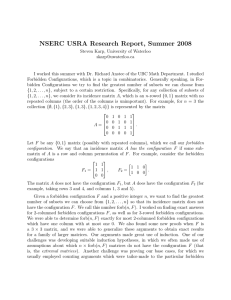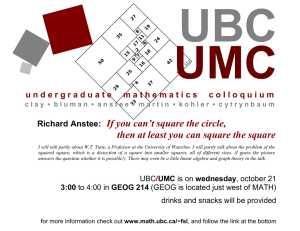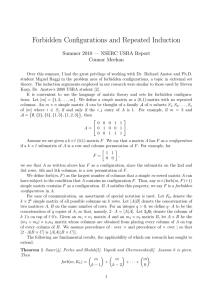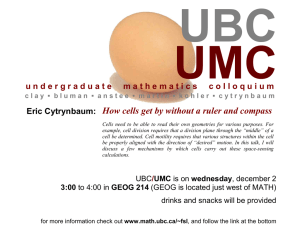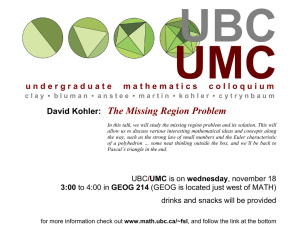Forbidden Families of Configurations Richard Anstee, UBC, Vancouver Joint work with Christina Koch
advertisement
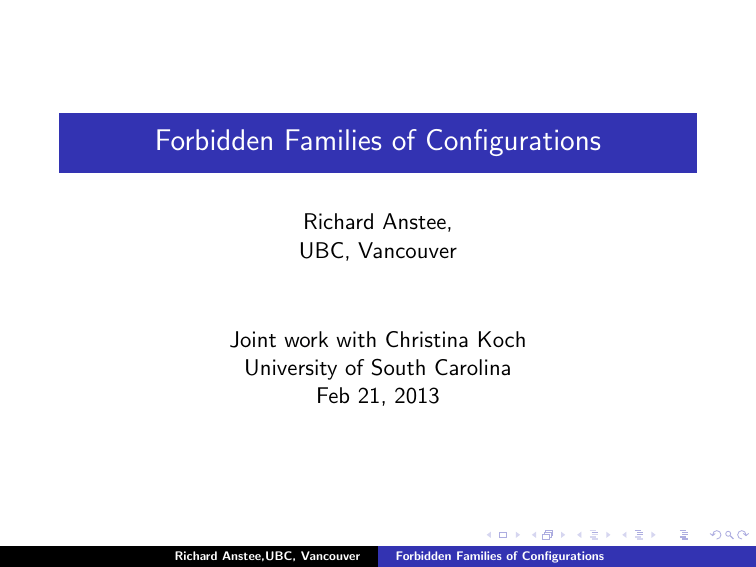
Forbidden Families of Configurations
Richard Anstee,
UBC, Vancouver
Joint work with Christina Koch
University of South Carolina
Feb 21, 2013
Richard Anstee,UBC, Vancouver
Forbidden Families of Configurations
Introduction
I have worked with a number of coauthors in this area: Farzin
Barekat, Laura Dunwoody, Ron Ferguson, Balin Fleming, Zoltan
Füredi, Jerry Griggs, Nima Kamoosi, Steven Karp, Peter Keevash,
Christina Koch, Connor Meehan, U.S.R. Murty, Miguel Raggi and
Attila Sali but there are works of other authors (some much older,
some recent) impinging on this problem as well. For example, the
definition of VC -dimension uses a forbidden configuration. A
survey article is now available at the
Electronic Journal of Combinatorics, Dynamic Survey 20.
Richard Anstee,UBC, Vancouver
Forbidden Families of Configurations
Christina Koch
Richard Anstee,UBC, Vancouver
Forbidden Families of Configurations
Consider the following
family of subsets of {1, 2, 3, 4}: A = ∅, {1, 2, 4}, {1, 4}, {1, 2}, {1, 2, 3}, {1, 3}
The incidence matrix A of the family A of subsets of {1, 2, 3, 4} is:
0 1 1 1 1 1
0 1 0 1 1 0
A=
0 0 0 0 1 1
0 1 1 0 0 0
Definition We say that a matrix A is simple if it is a (0,1)-matrix
with no repeated columns.
Definition We define kAk to be the number of columns in A.
kAk = 6 = |A|
Richard Anstee,UBC, Vancouver
Forbidden Families of Configurations
Definition Given a matrix F , we say that A has F as a
configuration (denoted F ≺ A) if there is a submatrix of A which is
a row and column permutation of F .
0 0 1 1
F =
0 1 0 1
≺
Richard Anstee,UBC, Vancouver
0
0
A=
0
0
1
1
0
1
1
0
0
1
1
1
0
0
1
1
1
0
Forbidden Families of Configurations
1
0
1
0
Definition Given a matrix F , we say that A has F as a
configuration (denoted F ≺ A) if there is a submatrix of A which is
a row and column permutation of F .
0 0 1 1
F =
0 1 0 1
≺
0
0
A=
0
0
1
1
0
1
1
0
0
1
1
1
0
0
1
1
1
0
1
0
1
0
Definitions
F = {F1 , F2 , . . . , Ft }
Avoid(m, F) = { A : A m-rowed simple, F 6≺ A for all F ∈ F}
forb(m, F) = maxA {kAk : A ∈ Avoid(m, F)}
Richard Anstee,UBC, Vancouver
Forbidden Families of Configurations
Some Main Results
Definition Let Kk denote the k × 2k simple matrix of all possible
columns on k rows.
Theorem (Sauer 72, Perles and Shelah 72, Vapnik and
Chervonenkis 71)
m
m
m
forb(m, Kk ) =
+
+· · ·+
which is Θ(mk−1 ).
k −1
k −2
0
Richard Anstee,UBC, Vancouver
Forbidden Families of Configurations
Some Main Results
Definition Let Kk denote the k × 2k simple matrix of all possible
columns on k rows.
Theorem (Sauer 72, Perles and Shelah 72, Vapnik and
Chervonenkis 71)
m
m
m
forb(m, Kk ) =
+
+· · ·+
which is Θ(mk−1 ).
k −1
k −2
0
When a matrix A has a copy of Kk on some k-set of rows S, then
we say that A shatters S. The results of Vapnik and Chervonenkis
were for application in Applied Probability, in Learning Theory.
One defines A to have VC-dimension k if k is the maximum
cardinality of a shattered set in A. There are further applications;
the last CanaDAM and the last SIAM Conference on Discrete
Mathematics had plenary talks containing applications.
Richard Anstee,UBC, Vancouver
Forbidden Families of Configurations
Main Bounds
Theorem (Sauer 72, Perles and Shelah 72, Vapnik and
Chervonenkis 71)
m
m
m
forb(m, Kk ) =
+
+· · ·+
which is Θ(mk−1 ).
k −1
k −2
0
Corollary Let F be a k × ` simple matrix. Then
forb(m, F ) = O(mk−1 ).
Theorem (Füredi 83). Let F be a k × ` matrix. Then
forb(m, F ) = O(mk ).
Richard Anstee,UBC, Vancouver
Forbidden Families of Configurations
Main Bounds
Theorem (Sauer 72, Perles and Shelah 72, Vapnik and
Chervonenkis 71)
m
m
m
forb(m, Kk ) =
+
+· · ·+
which is Θ(mk−1 ).
k −1
k −2
0
Corollary Let F be a k × ` simple matrix. Then
forb(m, F ) = O(mk−1 ).
Theorem (Füredi 83). Let F be a k × ` matrix. Then
forb(m, F ) = O(mk ).
Problem Given F , can we predict the behaviour of forb(m, F )?
Richard Anstee,UBC, Vancouver
Forbidden Families of Configurations
Let Ck denote the k × k vertex-edge incidence
of length k.
1 0
1 0 1
1 1
e.g. C3 = 1 1 0 , C4 =
0 1
0 1 1
0 0
Richard Anstee,UBC, Vancouver
matrix of the cycle
0
0
1
1
1
0
.
0
1
Forbidden Families of Configurations
Let Ck denote the k × k vertex-edge incidence
of length k.
1 0
1 0 1
1 1
e.g. C3 = 1 1 0 , C4 =
0 1
0 1 1
0 0
matrix of the cycle
0
0
1
1
1
0
.
0
1
Matrices in Avoid(m, {C3 , C5 , C7 , . . .}) are called
Balanced Matrices.
Theorem forb(m, {C3 , C5 , C7 , . . .}) = forb(m, C3 )
Richard Anstee,UBC, Vancouver
Forbidden Families of Configurations
Let Ck denote the k × k vertex-edge incidence
of length k.
1 0
1 0 1
1 1
e.g. C3 = 1 1 0 , C4 =
0 1
0 1 1
0 0
matrix of the cycle
0
0
1
1
1
0
.
0
1
Matrices in Avoid(m, {C3 , C5 , C7 , . . .}) are called
Balanced Matrices.
Theorem forb(m, {C3 , C5 , C7 , . . .}) = forb(m, C3 )
Matrices in Avoid(m, {C3 , C4 , C5 , C6 , . . .}) are called
Totally Balanced Matrices.
Theorem forb(m, {C3 , C4 , C5 , C6 , . . .}) = forb(m, C3 )
Richard Anstee,UBC, Vancouver
Forbidden Families of Configurations
The inequality forb(m, {C3 , C4 , C5 , C6 , . . .}) ≤ forb(m, C3 ) is quite
easy.
Lemma If F 0 ⊂ F then forb(m, F) ≤ forb(m, F 0 ).
Obviously the potential difficulty in obtaining equality is a
construction but in my Ph.D. thesis I had shown that any
m × forb(m, C3 ) simple matrix is in fact totally balanced. Thus we
have
forb(m, {C3 , C4 , C5 , C6 , . . .}) = forb(m, C3 ).
Richard Anstee,UBC, Vancouver
Forbidden Families of Configurations
A Product Construction
The building blocks of our product
1 0 0 0
0 1
0 1 0 0
c
1 0
I4 =
0 0 1 0 , I4 = 1 1
0 0 0 1
1 1
Richard Anstee,UBC, Vancouver
constructions are I , I c and
1 1
1 1 1
0 1 1
1 1
, T4 =
0 0 1
0 1
1 0
0 0 0
Forbidden Families of Configurations
T:
1
1
1
1
Definition Given an m1 × n1 matrix A and a m2 × n2 matrix B we
define the product A × B as the (m1 + m2 ) × (n1 n2 ) matrix
consisting of all n1 n2 possible columns formed from placing a
column of A on top of a column of B. If A, B are simple, then
A × B is simple. (A, Griggs, Sali 97)
1 1 1 0 0 0 0 0 0
0 0 0 1 1 1 0 0 0
1 0 0
1 1 1
0 0 0 0 0 0 1 1 1
0 1 0 × 0 1 1 =
1 1 1 1 1 1 1 1 1
0 0 1
0 0 1
0 1 1 0 1 1 0 1 1
0 0 1 0 0 1 0 0 1
Given p simple matrices A1 , A2 , . . . , Ap , each of size m/p × m/p,
the p-fold product A1 × A2 × · · · × Ap is a simple matrix of size
m × (mp /p p ) i.e. Θ(mp ) columns.
Richard Anstee,UBC, Vancouver
Forbidden Families of Configurations
Definition Given an m1 × n1 matrix A and a m2 × n2 matrix B we
define the product A × B as the (m1 + m2 ) × (n1 n2 ) matrix
consisting of all n1 n2 possible columns formed from placing a
column of A on top of a column of B. If A, B are simple, then
A × B is simple. (A, Griggs, Sali 97)
1 1 1 0 0 0 0 0 0
0 0 0 1 1 1 0 0 0
1 0 0
1 1 1
0 0 0 0 0 0 1 1 1
0 1 0 × 0 1 1 =
1 1 1 1 1 1 1 1 1
0 0 1
0 0 1
0 1 1 0 1 1 0 1 1
0 0 1 0 0 1 0 0 1
Given p simple matrices A1 , A2 , . . . , Ap , each of size m/p × m/p,
the p-fold product A1 × A2 × · · · × Ap is a simple matrix of size
m × (mp /p p ) i.e. Θ(mp ) columns.
Richard Anstee,UBC, Vancouver
Forbidden Families of Configurations
The Conjecture
Definition Let x(F ) denote the largest p such that there is a
p-fold product which does not contain F as a configuration where
the p-fold product is A1 × A2 × · · · × Ap where each
c ,T
Ai ∈ {Im/p , Im/p
m/p }.
Richard Anstee,UBC, Vancouver
Forbidden Families of Configurations
The Conjecture
Definition Let x(F ) denote the largest p such that there is a
p-fold product which does not contain F as a configuration where
the p-fold product is A1 × A2 × · · · × Ap where each
c ,T
Ai ∈ {Im/p , Im/p
m/p }.
Conjecture (A, Sali 05) forb(m, F ) is Θ(mx(F ) ).
In other words, we predict our product constructions with the three
building blocks {I , I c , T } determine the asymptotically best
constructions.
Richard Anstee,UBC, Vancouver
Forbidden Families of Configurations
The Conjecture
Definition Let x(F ) denote the largest p such that there is a
p-fold product which does not contain F as a configuration where
the p-fold product is A1 × A2 × · · · × Ap where each
c ,T
Ai ∈ {Im/p , Im/p
m/p }.
Conjecture (A, Sali 05) forb(m, F ) is Θ(mx(F ) ).
In other words, we predict our product constructions with the three
building blocks {I , I c , T } determine the asymptotically best
constructions.
The conjecture has been verified for k × ` F where k = 2 (A,
Griggs, Sali 97) and k = 3 (A, Sali 05) and ` = 2 (A, Keevash 06)
and for k-rowed F with bounds Θ(mk−1 ) or Θ(mk ) plus other
cases.
Richard Anstee,UBC, Vancouver
Forbidden Families of Configurations
Forbidden Families can fail Conjecture
Definition ex(m, H) is the maximum number of edges in a
(simple) graph G on m vertices that has no subgraph H.
A ∈ Avoid(m, 13 ) will be a matrix with up to m + 1 columns of
sum 0 or sum 1 plus columns of sum 2 which can be viewed as the
vertex-edge incidence matrix of a graph.
Assume p = |V (H)| and q = |E (H)|. Let I (H) denote the p × q
vertex-edge incidence matrix associated with H.
Theorem forb(m, {13 , I (H)}) = m + 1 + ex(m, H).
In this talk I (C4 ) = C4 . (Also C4 = I2 × I2 )
Richard Anstee,UBC, Vancouver
Forbidden Families of Configurations
Forbidden Families can fail Conjecture
Definition ex(m, H) is the maximum number of edges in a
(simple) graph G on m vertices that has no subgraph H.
A ∈ Avoid(m, 13 ) will be a matrix with up to m + 1 columns of
sum 0 or sum 1 plus columns of sum 2 which can be viewed as the
vertex-edge incidence matrix of a graph.
Assume p = |V (H)| and q = |E (H)|. Let I (H) denote the p × q
vertex-edge incidence matrix associated with H.
Theorem forb(m, {13 , I (H)}) = m + 1 + ex(m, H).
In this talk I (C4 ) = C4 . (Also C4 = I2 × I2 )
Theorem forb(m, {13 , C4 }) = m + 1 + ex(m, C4 ) which is
Θ(m3/2 ).
Theorem forb(m, {13 , C6 }) = m + 1 + ex(m, C6 ) which is
Θ(m4/3 ).
Richard Anstee,UBC, Vancouver
Forbidden Families of Configurations
Forbidden Families can pass Conjecture
Theorem (Balogh and Bollobás) Let k be given. Then there is a
constant ck so that forb(m, {Ik , Ikc , Tk }) = ck .
We note that there is no obvious product construction.
Note that ck ≥ 2k−2
k−1 by taking all columns of column sum at
most k − 1 that arise from the k − 1-fold product
Tk−1 × Tk−1 × · · · × Tk−1 .
Richard Anstee,UBC, Vancouver
Forbidden Families of Configurations
Let F = {F1 , F2 , . . . , Fk } and G = {G1 , G2 , . . . , G` }.
Lemma Let F and G have the property that for every Gi , there is
some Fj with Fj ≺ Gi . Then forb(m, F) ≤ forb(m, G).
Richard Anstee,UBC, Vancouver
Forbidden Families of Configurations
Let F = {F1 , F2 , . . . , Fk } and G = {G1 , G2 , . . . , G` }.
Lemma Let F and G have the property that for every Gi , there is
some Fj with Fj ≺ Gi . Then forb(m, F) ≤ forb(m, G).
Theorem Let F be given. Then either there is a constant c with
forb(m, F) = c or forb(m, F) is Ω(m).
Proof: We start using G = {Ip , Ipc , Tp } with p suitably large.
Either we have the property that there is some Fr ≺ Ip , and some
Fs ≺ Ipc and some Ft ≺ Tp in which case
forb(m, F) ≤ forb(m, {Ip , Ipc , Tp }) = O(1)
or
without loss of generality we have Fj 6≺ Ip for all j and hence
Im ∈ Avoid(m, F) and so forb(m, F) is Ω(m).
Richard Anstee,UBC, Vancouver
Forbidden Families of Configurations
A pair of Configurations with quadratic bounds
1 0 0
0
0 1 0
1
×
0 0 1
1
I3
e.g. F2 (1, 2, 2, 1) =
1
0
1
I3c
0
0
1 1 1 0
0 0 0 1
1
0 0 0 0
1
=
0 1 1 0
0
1 0 1 1
1 1 0 1
0 0 1 1 1
∈
/I
1 1 0 0 1
Richard Anstee,UBC, Vancouver
0
1
0
1
0
1
0
1
0
1
1
0
0
0
1
0
1
1
× Ic.
Forbidden Families of Configurations
0
0
1
1
0
1
0
0
1
1
1
0
A pair of Configurations with quadratic bounds
1 1 1 0 0 0 0 0 0
0 0 0 1 1 1 0 0 0
1 1
0 0 0 0 0 0 1 1 1
0 1
=
0 1 1 0 1 1 0 1 1
1 0
1 0 1 1 0 1 1 0 1
I3c
1 1 0 1 1 0 1 1 0
0 0 0 1 1 1
e.g. F2 (1, 2, 2, 1) =
∈
/ I × Ic.
0 1 1 0 0 1
c
Im/2 × Im/2
is an m × m2 /4 simple matrix avoiding F2 (1, 2, 2, 1),
so forb(m, F2 (1, 2, 2, 1)) is Ω(m2 ).
2
(A, Ferguson, Sali 01 forb(m, F2 (1, 2, 2, 1)) = b m4 c + m1 + m0 )
1 0 0
0
0 1 0
1
×
0 0 1
1
I3
Richard Anstee,UBC, Vancouver
Forbidden Families of Configurations
A pair of Configurations with quadratic bounds
1 0 0
e.g. I3 = 0 1 0 ∈
/ T × T.
0 0 1
1
1 1 1
1 1 1
1
1
1 1 0
1 1 0
×
=
1
1 0 0
1 0 0
1
T3
T3
1
Richard Anstee,UBC, Vancouver
1
1
1
1
1
0
1
1
1
1
0
0
1
1
0
1
1
1
1
1
0
1
1
0
1
1
0
1
0
0
1
0
0
1
1
1
Forbidden Families of Configurations
1
0
0
1
1
0
1
0
0
1
0
0
A pair of Configurations with quadratic bounds
1 0 0
e.g. I3 = 0 1 0 ∈
/ T × T.
0 0 1
1
1 1 1
1 1 1
1
1
1 1 0
1 1 0
×
=
1
1 0 0
1 0 0
1
T3
T3
1
2
Tm/2 × Tm/2 is an m × m /4 simple
2 ).
so forb(m, I3 ) is Ω(m
m
(forb(m, I3 ) = 2 + m1 + m0 )
Richard Anstee,UBC, Vancouver
1 1 1 1 1
1 1 1 1 1
1 1 0 0 0
1 1 1 1 1
1 0 1 1 0
0 0 1 0 0
matrix avoiding
1
0
0
1
1
1
I3 ,
Forbidden Families of Configurations
1
0
0
1
1
0
1
0
0
1
0
0
By considering the construction I × I c that avoids F2 (1, 2, 2, 1)
and the construction T × T that avoids I3 , we note that we have
only linear obvious constructions that avoid both F2 (1, 2, 2, 1) and
I3 . We are led to the following:
Theorem forb(m, {I3 , F2 (1, 2, 2, 1)}) is Θ(m).
More is true:
Theorem forb(m, {2 · I3 , F2 (1, 2, 2, 1)}) is Θ(m).
Richard Anstee,UBC, Vancouver
Forbidden Families of Configurations
By considering the construction I × I c that avoids F2 (1, 2, 2, 1)
and the construction T × T that avoids I3 , we note that we have
only linear obvious constructions that avoid both F2 (1, 2, 2, 1) and
I3 . We are led to the following:
Theorem forb(m, {I3 , F2 (1, 2, 2, 1)}) is Θ(m).
More is true:
Theorem forb(m, {2 · I3 , F2 (1, 2, 2, 1)}) is Θ(m).
We are unable to extend this to the following although it seems to
be true.
Conjecture forb(m, {t · I3 , F2 (1, t, t, 1)}) is Θ(m).
Richard Anstee,UBC, Vancouver
Forbidden Families of Configurations
This idea was shown to hold for all pairs of the minimal
quadratically bounded configurations.
Richard Anstee,UBC, Vancouver
Forbidden Families of Configurations
Standard Induction
Let A ∈ Avoid(m, F). Decompose A as follows by deleting row r
and collecting any repeated columns in Cr :
row r
0 ··· 0 1 ··· 1
A=
.
Br
Cr Cr
Dr
Now [Br Cr Dr ] ∈ Avoid(m − 1, F) and so
k[Br Cr Dr ]k ≤ forb(m − 1, F). Also Cr ∈ Avoid(m − 1, F 0 ) where
F 0 is the (minimal) set of configurations F 0 such that there is a
configuration F ∈ F with F ≺ F 0 × [0 1].
We are ready for induction using
forb(m, F) ≤ forb(m − 1, F) + forb(m − 1, F 0 )
Richard Anstee,UBC, Vancouver
Forbidden Families of Configurations
Balogh Bollobás extended
Using our very standard induction one can prove the following.
Theorem Let k be given. Then forb(m, {2 · Ik , 2 · Ikc , 2 · Tk }) is
Θ(m).
Proof: We apply the standard induction noting that
Cr ∈ Avoid(m, {Ik , Ikc , Tk } and so kCr k is O(1) and so by
induction forb(m, {2 · Ik , 2 · Ikc , 2 · Tk }) is Θ(m). We note that
Im ∈ Avoid(m, {2 · Ik , 2 · Ikc , 2 · Tk }).
Richard Anstee,UBC, Vancouver
Forbidden Families of Configurations
Balogh Bollobás extended
Using our very standard induction one can prove the following.
Theorem Let k be given. Then forb(m, {2 · Ik , 2 · Ikc , 2 · Tk }) is
Θ(m).
Proof: We apply the standard induction noting that
Cr ∈ Avoid(m, {Ik , Ikc , Tk } and so kCr k is O(1) and so by
induction forb(m, {2 · Ik , 2 · Ikc , 2 · Tk }) is Θ(m). We note that
Im ∈ Avoid(m, {2 · Ik , 2 · Ikc , 2 · Tk }).
Conjecture Let k, t be given. Then forb(m, {t · Ik , t · Ikc , t · Tk }) is
Θ(m).
Richard Anstee,UBC, Vancouver
Forbidden Families of Configurations
Balogh Bollobás extended
Using our very standard induction one can prove the following.
Theorem Let k be given. Then forb(m, {2 · Ik , 2 · Ikc , 2 · Tk }) is
Θ(m).
Proof: We apply the standard induction noting that
Cr ∈ Avoid(m, {Ik , Ikc , Tk } and so kCr k is O(1) and so by
induction forb(m, {2 · Ik , 2 · Ikc , 2 · Tk }) is Θ(m). We note that
Im ∈ Avoid(m, {2 · Ik , 2 · Ikc , 2 · Tk }).
Conjecture Let k, t be given. Then forb(m, {t · Ik , t · Ikc , t · Tk }) is
Θ(m).
Theorem forb(m, {t · Ik , t · Ik c , t · Tk }) is Θ(m) for k = 3, 4.
Richard Anstee,UBC, Vancouver
Forbidden Families of Configurations
Balogh Bollobás extended
Theorem (A, Meehan 12) Let F = {F1 , F2 , F3 } be a family of
p-rowed simple matrices with p ≥ k
such that columns of F1 |{1,2,...,k} are contained in [0k Ik ],
such that columns of F2 |{1,2,...,k} are contained in [1k Ikc ]
and such that columns of F3 |{1,2,...,k} are contained in [0k Tk ].
Then forb(m, F) is O(mp−k ).
Richard Anstee,UBC, Vancouver
Forbidden Families of Configurations
An unusual Bound
Theorem (A,Koch,Raggi,Sali 12) forb(m, {T2 × T2 , I2 × I2 }) is
Θ(m3/2 ).
1 1 1 1
1 1 0 0
0 0 1 1
0 0 1 1
T2 × T2 =
1 1 1 1 , I2 × I2 = 1 0 1 0
0 1 0 1
0 1 0 1
We showed initially that forb(m, {T2 × T2 , T2 × I2 , I2 × I2 }) is
Θ(m3/2 ) but Christina Koch realized that we ought to be able to
drop T2 × I2 and we were able to redo the proof (which simplified
slightly!).
Richard Anstee,UBC, Vancouver
Forbidden Families of Configurations
Miguel Raggi, Attila Sali
Richard Anstee,UBC, Vancouver
Forbidden Families of Configurations
Induction
Let A be an m × forb(m, F) simple matrix with no configuration in
F = {T2 × T2 , I2 × I2 }. We can select a row r and reorder rows
and columns to obtain
row r
0 ··· 0 1 ··· 1
A=
.
Br
Cr Cr
Dr
Richard Anstee,UBC, Vancouver
Forbidden Families of Configurations
Induction
Let A be an m × forb(m, F) simple matrix with no configuration in
F = {T2 × T2 , I2 × I2 }. We can select a row r and reorder rows
and columns to obtain
row r
0 ··· 0 1 ··· 1
A=
.
Br
Cr Cr
Dr
To show kAk is O(m3/2 ) it would suffice to show kCr k is O(m1/2 )
for some choice of r . Our proof shows that assuming
kCr k > 20m1/2 for all choices r results in a contradiction. In
particular, associated with Cr is a set of rows S(r ) with
S(r ) ≥ 5m1/2 . We let S(r ) = {r1 , r2 , r3 , . . .}. After some work we
show that |S(ri ) ∩ S(rj )| ≤ 5. Then we have
|S(r1 ) ∪ S(r2 ) ∪ S(r3 ) ∪ · · · |
= |S(r1 )| + |S(r2 )\S(r1 )| + |S(r3 )\(S(r1 ) ∪ S(r2 ))| + · · ·
= 5m1/2 + (5m1/2 − 5) + (5m1/2 − 10) + · · · > m ! ! !
Richard Anstee,UBC, Vancouver
Forbidden Families of Configurations
